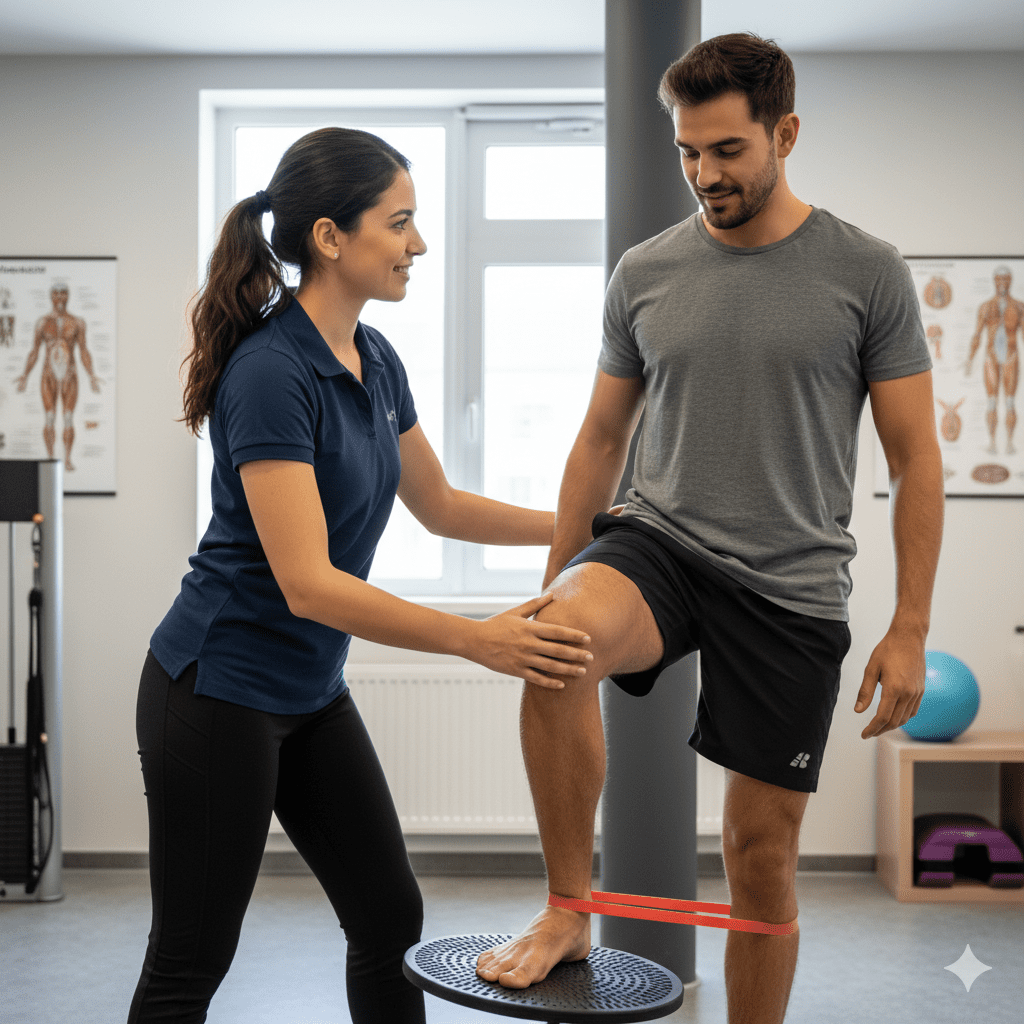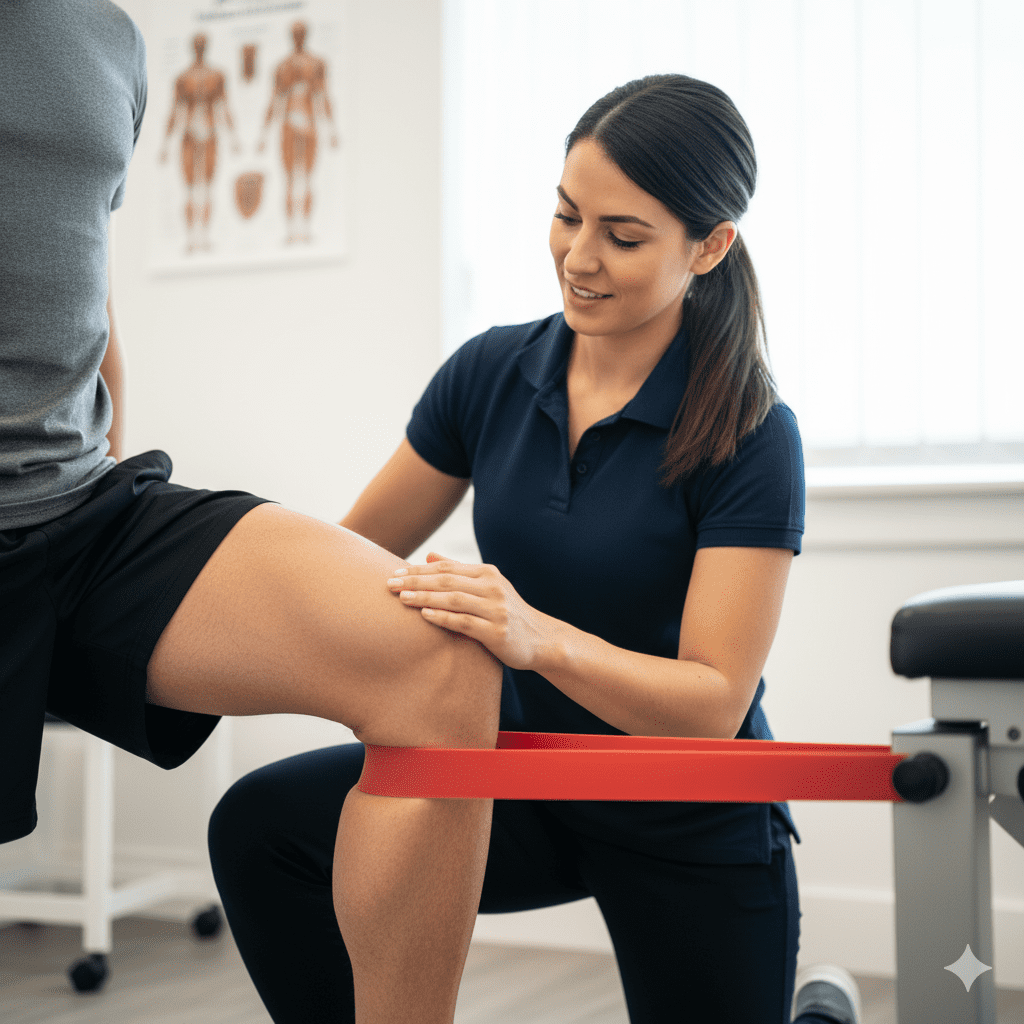
Have you ever hurt your knee or ankle…
and noticed your muscles suddenly feel weaker — even though they look perfectly fine?
It’s not your imagination.
And it’s not muscle loss either.
It’s your nervous system doing its job — trying to protect you.
As a physiotherapist, I see this every week.
Patients walk in worried, saying,
“I didn’t lose muscle, but it just doesn’t feel strong anymore.”
That’s the brain talking — not the muscle.
The Mystery of Post-Injury Muscle Weakness
When you injure a joint — whether it’s your knee, ankle, shoulder, or even your wrist — your body instantly changes how it moves.
It’s a built-in defense mechanism.
This protective response is known as Arthrogenic Muscle Inhibition, or AMI.
It sounds complex, but the concept is simple.
Your brain temporarily “switches off” the muscle to prevent further injury.
It’s not that the muscle is damaged.
It’s that your nervous system has decided to limit movement until it feels safe again.
How the Brain and Body Communicate After Injury
Let’s simplify the science.
- You injure a joint.
- Sensory receptors in that joint — called mechanoreceptors — send distress signals to your spinal cord and brain.
- Your brain interprets those signals as a threat.
- In response, it reduces the electrical output to the muscles surrounding the injured joint.
That’s Arthrogenic Muscle Inhibition — the brain’s protective brake.
It’s like your body saying,
“Don’t move too much yet. Let’s keep things safe.”
The result?
The muscle feels weaker.
It doesn’t activate fully.
And your movements lose strength and stability — even though the muscle tissue itself is completely healthy.
This Weakness Isn’t a Failure — It’s Protection
When you understand this, your perspective shifts.
Your body isn’t failing you.
It’s protecting you.
This neural inhibition is actually a sign that your body’s defense system is working.
The real challenge begins when this inhibition lasts longer than it should.
When the brain keeps “guarding” the muscle even after the injury has healed,
it leads to:
- Prolonged weakness
- Reduced coordination
- Imbalanced movement patterns
- Increased risk of re-injury
That’s when physiotherapy becomes essential.
How Physiotherapy Re-Trains the Brain–Muscle Connection

Physiotherapy doesn’t just strengthen muscles — it reprograms the nervous system.
Here’s how we help your body “trust” movement again 👇
1. Activation Exercises
We start with gentle, isolated movements that remind your brain how to engage the inhibited muscle.
For example:
- Quad setting after knee injury
- Glute activation after hip trauma
- Ankle pumps after sprain
These small, precise movements act like a “wake-up call” to your motor neurons.
2. Neuromuscular Re-education
This is the science of rebuilding brain-to-muscle communication.
We use tactile cues, visual feedback, and proprioceptive drills to restore coordination.
Think of it as teaching your brain to trust your body again.
Every repetition rewires your neural circuits.
Over time, those inhibited pathways light up again — and full strength returns.
3. Proprioceptive Training
Balance boards.
Single-leg stands.
Dynamic stability drills.
These exercises train your joint receptors to send accurate signals back to the brain.
When your brain senses stability, it stops limiting movement.
That’s when strength returns — naturally.
4. Manual Therapy
Gentle mobilization, joint glides, and soft tissue work help improve the joint’s sensory input.
When the brain receives healthy movement signals, it reduces its “danger alert.”
This process reboots the muscle activation sequence.
It’s like resetting your body’s internal safety software.
5. Progressive Strength Training
Once the neural connection is restored, we move into strength work.
Here, the goal is not just muscle gain — but control, timing, and endurance.
That’s the difference between training a muscle and retraining movement.
Why Traditional Strength Work Alone Doesn’t Always Help
Many people return to the gym after injury thinking,
“If I just strengthen it more, it’ll feel fine.”
But without addressing the neurological inhibition, no amount of squats or lunges will fully fix the problem.
That’s why physiotherapy combines both:
Neural activation + Strength restoration.
One without the other is incomplete.
Your Brain Remembers Everything
Here’s something incredible:
Even after months of inhibition, your brain can relearn full control.
This process is called neuroplasticity — your brain’s ability to form new connections.
It’s the same principle that helps stroke patients regain movement.
With guided physiotherapy, consistent practice, and trust in the process,
the body and brain rebuild their partnership.
And when they do — strength returns, balance improves, and pain fades.
Why This Matters for Recovery
Understanding why your muscle feels weak after an injury changes everything.
It helps you stay patient.
It helps you avoid unnecessary fear.
And it helps you focus on the right kind of rehabilitation — not just strength, but connection.
When you stop blaming your body and start working with it, healing becomes faster and more complete.
How to Support Your Brain–Muscle Healing at Home
Here are some simple ways you can accelerate your recovery naturally 👇
✅ Move Mindfully — Avoid holding tension. Move within a comfortable range, not to the point of pain.
✅ Visualize Activation — Research shows mental imagery can enhance neural recovery. Picture the muscle engaging smoothly.
✅ Stay Consistent — The nervous system learns through repetition. Daily movement is key.
✅ Breathe Deeply — Oxygen supports neuromuscular reactivation.
✅ Trust the Process — Healing is not instant, but your brain is always listening and adapting.
Real-Life Transformation
At Physiogain, I’ve seen hundreds of patients regain full strength after long-standing weakness.
Like Riya, who struggled to climb stairs for months after an ankle sprain.
She thought her leg was permanently weak.
Within six sessions of neuromuscular re-education and proprioceptive drills, she started running again.
Or Amit, who feared knee surgery after a ligament injury.
Through activation therapy and progressive loading, he restored 90% of strength within eight weeks — completely drug-free.
These aren’t miracles.
They’re the body’s natural science — guided by movement, consistency, and care.
Your Body Isn’t Broken — It’s Communicating
That’s the truth I wish more people knew.
When your muscle feels weak after an injury, it’s not broken.
It’s simply your body saying, “Let’s slow down and feel safe first.”
Physiotherapy bridges that gap between fear and function.
Between protection and power.
And once your brain feels safe again —
your body unleashes its full potential.
Key Takeaway

Pain and weakness are not enemies.
They’re messages.
And when you listen, you heal.
So next time your muscle feels weak after an injury, remember —
you don’t need to fight your body.
You need to reconnect with it.
Physiotherapy isn’t just about movement.
It’s about communication, trust, and neural harmony.
Your body already knows how to heal.
You just have to remind it how.